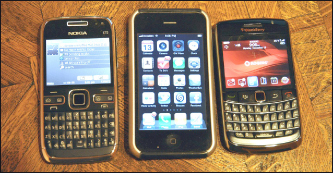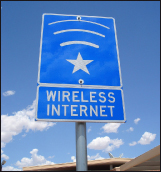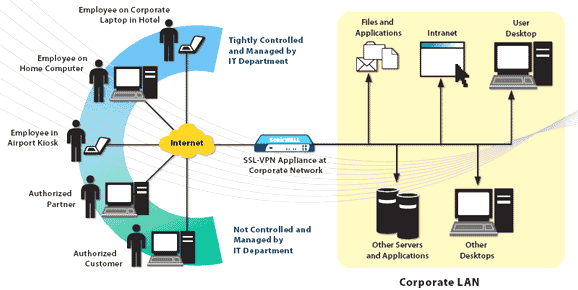An insight into why consumer smartphones matter to businesses and how a universal, platform-agnostic approach to security best practices treats all smartphones as uncontrolled end points
by Matthew Dieckman, Dell SonicWall
 The consumerization of IT has led to the proliferation of personal smartphone devices used as corporate network end points. However, when allowing the use of consumer smartphones, companies must contend with related problems, ranging from uncontrolled bandwidth consumption to exposing new conduits for malware attack and data leakage. The growing array of platforms, as well as the growing influence of consumers in corporate smartphone deployments, demands a universal, platform-agnostic approach to security best practices, which treats all smartphones as uncontrolled end points. Organizations can implement these practices using currently available technologies, such as SSL VPNs and Next-Generation Firewalls or Unified Threat Management Firewalls with Application Intelligence and Control.
The consumerization of IT has led to the proliferation of personal smartphone devices used as corporate network end points. However, when allowing the use of consumer smartphones, companies must contend with related problems, ranging from uncontrolled bandwidth consumption to exposing new conduits for malware attack and data leakage. The growing array of platforms, as well as the growing influence of consumers in corporate smartphone deployments, demands a universal, platform-agnostic approach to security best practices, which treats all smartphones as uncontrolled end points. Organizations can implement these practices using currently available technologies, such as SSL VPNs and Next-Generation Firewalls or Unified Threat Management Firewalls with Application Intelligence and Control.
Impact of consumerization
As a term, ‘Consumerization of IT’ is an industry-accepted idiom introduced by Gartner, who reports that the majority of new technologies enterprises currently adopt for their information systems will have roots in consumer applications. At the same time, because employees now work everywhere at any time and need constant access to key corporate information, they rely upon the same smartphone technology they use in their personal lives to extend their workday and increase efficiency. However, IT can no longer force users to carry one IT-managed smartphone (e.g., RIM BlackBerry) for work and another consumer device for personal use. With an ever-increasing percentage of the workforce having grown up with the Web and cell phones, more workers feel entitled to greater freedom in selecting their business computing devices, and smartphones are their devices of choice. More than a third of consumers in Western Europe will access the Internet using their mobile phones by 2014, predict forecasters.
According to various other reports, 85 percent of Americans age 15-18 own a mobile phone. Those now joining the workforce tend to believe that the technology they have at home is better than the one they have at work. Among “millennials,” 69 percent will use whatever application, device or technology they want, regardless of source or corporate IT policies. Fewer than half will stick to company-issued devices. Moreover, a greater percentage compared with older employees will regularly store corporate data on personal smartphones. This trend will only increase over time. The power of users now rules the day. IT has effectively lost its ability to constrain the choice of smartphone access in a corporate setting. Further vexing IT administrators is that the scope of the issue continues to expand as new categories of devices are introduced to the corporate network, including devices such as the Apple iPhone and iPad.
Tipping point
Other analysis shows the ubiquitous acceptance of smartphones as a business tool has reached its tipping point. Analysts forecasted smartphone sales of 2.5 billion units by 2015, with compound annual growth rates of 26 percent in Asia Pacific (29 percent in China alone), 23 percent in North America, 33 percent in South America, 20 percent in Western Europe, 25 percent in Eastern Europe, and 21 percent in the Middle East and Africa. Nearly half of U.S. consumers access the Internet with their phones and one in three U.S. information workers uses a personal mobile phone for work. Going forward, analysts forecast that mobile phones will overtake PCs as the most common Web access devices worldwide by 2013, with the combined installed base of smartphones and browser-equipped enhanced phones surpassing over 1.82 billion units. Moreover, by 2014, researchers say more than 3 billion will be able to conduct transactions via mobile or Internet technology.
The primary driving factors for technology research and development today are no longer business, industry or the military, but consumers. According to Intel, consumers are the number one users of semiconductors, having surpassed IT and government in 2004. Gartner has stated that consumer markets will drive much of the industry’s underlying research and development, rather than the military and business markets. As a result, end users look less to corporate IT as a source for technical leadership, but rather to consumer oriented vendors that cater to their own personal needs. Armed with the latest cutting-edge technology at their disposal, these corporate ‘prosumers’ are no longer willing to be passive recipients of IT allocations.
A moving target
Face the facts: there will be many rapid changes in smartphone platforms, beyond the control of corporate IT. Administrators must deal with multiple operating system platforms, including Apple iOS, Google Android, Nokia Symbian and Microsoft Windows Mobile, with an additional potential for new providers from emerging technology powerhouses such as China. As a result, significant IT investment in securing any particular consumer smartphone platform is practically untenable over time.
IT must have an agnostic approach to smartphone platforms to support multiple platforms for their users, as well as provide contingency for access continuity. For example, BlackBerry users in certain countries recently faced threatened service outages that could have required them to switch to a different platform. Subsequently, to minimize risk of regional loss-of-service, a global business cannot depend solely upon the viability of a single smartphone vendor’s platform but instead, must deploy smartphone solutions that are able to facilitate multiple platforms. The need for platform flexibility could potentially undermine IT controls gained from mandated deployments of single-vendor platforms, such as BlackBerry Enterprise Server (BES). The burden of juggling support for multiple smartphone platforms can also take IT resources away from securing other aspects of the network. Ultimately, new business technology should enhance employee productivity, not overwhelm it. Organizations must bear in mind the impact that individually supporting and securing multiple smartphone platforms will have upon administrative overhead and total operating costs.
IT control
Smartphones operate in two worlds: they can connect to the corporate network over wireless, or bypass the network entirely using mobile cellular connections. That means they might download malware from the Web over 4G, and then disseminate it to the network over the corporate Wi-Fi network. Transferring data in and out of the corporate network, smartphones are beyond IT control. It is harder for IT to control what users do with their smartphone devices, and how these devices expose business data to security threats. Even if IT issues them, any endpoint device that can bypass security measures is insecure.
Data leakage and loss
 The proliferation of smartphones in corporate environments creates new and wider potential for data loss and leakage, whether by theft, unauthorized access or unauthorized transmission. Determined professionals can ultimately undermine even ‘unhackable’ smartphone platforms. Smartphones may also retain sensitive or proprietary data while connected to the corporate wireless network, then leak it over unsecured cellular to the Web—and IT has no recourse. In addition, a growing amount of data loss via smartphones originates within the corporate organization. Whether unintentionally, maliciously or driven by profit, a growing amount of sensitive and proprietary data is lost and leaked via smartphone email attachments and FTP uploads.
The proliferation of smartphones in corporate environments creates new and wider potential for data loss and leakage, whether by theft, unauthorized access or unauthorized transmission. Determined professionals can ultimately undermine even ‘unhackable’ smartphone platforms. Smartphones may also retain sensitive or proprietary data while connected to the corporate wireless network, then leak it over unsecured cellular to the Web—and IT has no recourse. In addition, a growing amount of data loss via smartphones originates within the corporate organization. Whether unintentionally, maliciously or driven by profit, a growing amount of sensitive and proprietary data is lost and leaked via smartphone email attachments and FTP uploads.
Locally resident smartphone data is only as secure as its Subscriber Information Module (SIM) card. Users more frequently lose smartphones than computers. Smartphone content is more vulnerable to theft by whoever finds the misplaced device, as network access codes, usernames and passwords are often unsecured. Even worse, users often pre-program this sensitive information into the handset for automatic log-on. In addition, thieves can thwart attempts by IT to wipe data remotely by simply by removing the SIM.
 The widespread practice of ‘jailbreaking’, or opening a phone to customize its features or functionality (such as to overcome restrictions on alternate mobile service carrier networks), also poses a serious security threat. For example, jailbreakers using Secure Shell (SSH) applications to enable full access to their smartphones often overlook updating their root passwords, making them accessible to outside attack. Additionally, jailbroken phones often void smartphone service agreements, and jailbroken systems often go untested in product update development. Moreover, jailbreakers often resell these compromised devices. According to one report, jailbreaking removes eighty-percent of the iPhone’s security precautions. Another study received data from approximately 4 million jailbroken devices; about 1.5 million of those had used a pirated application.
The widespread practice of ‘jailbreaking’, or opening a phone to customize its features or functionality (such as to overcome restrictions on alternate mobile service carrier networks), also poses a serious security threat. For example, jailbreakers using Secure Shell (SSH) applications to enable full access to their smartphones often overlook updating their root passwords, making them accessible to outside attack. Additionally, jailbroken phones often void smartphone service agreements, and jailbroken systems often go untested in product update development. Moreover, jailbreakers often resell these compromised devices. According to one report, jailbreaking removes eighty-percent of the iPhone’s security precautions. Another study received data from approximately 4 million jailbroken devices; about 1.5 million of those had used a pirated application.
A smartphone that can access the network via a corporate wireless access point represents the same kind of threat as any other endpoint. The problem is only different in that a phone is less likely to be running security software. A somewhat uncommon threat is the possible compromise of a phone via its Bluetooth connection. This requires physical proximity and specific knowledge. However, if the ultimate target is a larger network, this may be worth the effort for a perpetrator.
Malware infection
As their numbers increase, smartphones become a more lucrative target for criminal attacks. The same threats that plague traditional computer operating systems can affect smartphones, disseminated in emails, social media sites, games, screen savers, instant messages, slide shows, or in some cases by shady URL shortening services, which make bogus redirecting links more difficult to identify. Smartphones can magnify malware distribution by spam, phishing, pharming and pretexting. Because smartphones are a more intimate communications channel than a computer, users are more likely to interact with files masquerading as personal communications. Likewise, users cannot as easily detect cues that a Web site is a false front on a handset with a small screen. Again, the infection may not be apparent even after perpetration, and propagate via smartphone across corporate IP networks.
Also, the sheer volume of interactive Web 2.0 and streaming media traffic over smartphones can affect corporate wireless network throughput. Some of these applications, such as streaming video applications, constantly evolve to avoid control. In addition, like any Web-facing endpoint device running applications over the network, smartphones present a potential channel for forced denial-of-service attacks.
Best Practices
Best practices demand that IT enforce sound smartphone policy with proven technology. IT should define, document and communicate smartphone use policy, and couple that policy with the deployment of corresponding enforcement solutions. Examples of documented IT policy include requiring users to set strong passwords on their smartphones (valuable in cases of lost devices, etc.) and report lost or stolen smartphones to IT immediately. Examples of enforcement solutions include security technologies that can recognize when solicited connections are originating from smartphones and provide differentiated access policies based on type of device and user authentication. The following best practices include approaches for both policy and technology.
- Establish SSL VPN access to corporate resources: instead of setting up, administering and updating separate security solutions for separate smartphone operating systems (e.g., Apple iOS, Google Android, Nokia Symbian and Microsoft Windows Mobile), IT could deploy a centralized Secure Sockets Layer Virtual Private Networking (SSL VPN) portal. An SSL VPN portal can provide authenticated and encrypted Web-based access to network resources agnostically, regardless of the smartphone operating systems using reverse proxy, and minimize demand on IT support. Moreover, when integrated with firewall technology to form a “clean VPN” solution, an SSL VPN, establishing an authorized Web portal, can enable tight controls on data management while providing superior security and malware protection for the corporate network.
- Vary access levels based on device interrogation: in conjunction with SSL VPN portal access, IT should utilize remote access technologies capable of interrogating remote devices to determine what level of access is appropriate based on device and user identity. An effective secure remote access solution should not grant a single level of trust to all connections, but vary levels of trust based on knowing the device’s security posture. Once this has been determined, the solution should assign and enforce appropriate levels of security policy to that connection. By limiting users from accessing and downloading sensitive data, this technology can reduce or eliminate broad data leakage threats, while still providing relevant data to support mobile workers.
- Require lost or stolen phones be reported immediately: smartphone policy should require that lost or stolen phones be reported immediately. Due to their inherent mobility and vulnerabilities, IT should treat smartphones as uncontrolled endpoints, whether or not they are company-issued. IT cannot always trust users to be the person they claim to be.
- Comprehensively scan all smartphone traffic: to protect network resources, IT should deploy a Next-Generation Firewall or Unified Threat Management (UTM) Firewall that can conduct deep packet inspection and comprehensively scan all smartphone traffic— whether over internal Wi-Fi, or going in or out of the network over SSL VPN—to protect against malware, intrusions, Trojans and viruses.
- Control data-in-flight: IT should be capable of inspecting outbound traffic for data leakage, even if that traffic is encrypted. At the same time, IT should scan all data-in-flight for malware, and prevent internally launched outbound botnet attacks that can damage corporate reputation and get business-critical email servers blacklisted.
- Maximize firewall throughput to eliminate latency: when smartphones are connected to the corporate network, in order to minimize impact upon latency sensitive applications, such as video conferencing and voice over IP (VoIP), the Next-Generation Firewall or UTM Firewall platform must be capable of comprehensively optimizing business-relevant smartphone traffic in real-time. IT can obtain such performance capability in solutions that integrate reassembly-free deep packet inspection methods with a high-speed multi-core processor architecture.
- Establish controls over smartphone application traffic: as primarily a Web-enabled device, smartphones enable access to applications such as social media and streaming video. To enforce adherence to corporate policy, IT should establish control over these applications, just like with other devices when connected directly to the corporate network. Application intelligence and control technology can extend firewall functionality to identify, categorize, control and report upon application usage over the corporate network from these devices.
- Establish smartphone wireless access security: analysts expect ninety-percent of smartphones to have Wi-Fi functionality by 2014. Security for wireless local area networks (WLANs) has to be at least on par with wired networks running deep packet inspection (DPI). IT should apply WPA2 as well as application intelligence and control to traffic from users connected to the corporate network over WiFi.
- Manage smartphone traffic bandwidth: organizations need to control converged voice-and-data communications enabled by smartphones when directly connected to the corporate network, while at the same time continuing to optimize quality of service (QoS) and bandwidth management, as well as prioritization on a per-application and per-user basis. Application-intelligent bandwidth management can dedicate both throughput to latency-sensitive smartphone applications such as VoIP, and limit bandwidth-consuming traffic, such as YouTube.
- Visualize bandwidth activity: to control the proper use of mobile networks, administrators need tools to view traffic and adjust network policy based on critical observations. This enables administrators to ensure bandwidth for smartphone traffic, while adjusting policy to restrict or block bandwidth-consuming traffic based upon a real-time view of bandwidth utilization, application and user traffic, and other user activity.
 To implement these best practices, IT requires solutions with the capability to enforce them, drawing on the following conclusions. The consumerization of personal smartphones in corporate environments has reached an irrevocable tipping point. While mandating and allocating corporate-issued devices will continue, end users will increasingly demand access to network resources from personal consumer smartphone devices. While riding this tide does offer potential business benefits, it comes with inherent risks. SonicWall solutions, including SSL VPN, Clean VPN, Next-Generation Firewall, UTM, Clean Wireless, and Application Intelligence, Control and Visualization, can help organizations easily implement best practices to secure smartphone use in corporate network environments.
To implement these best practices, IT requires solutions with the capability to enforce them, drawing on the following conclusions. The consumerization of personal smartphones in corporate environments has reached an irrevocable tipping point. While mandating and allocating corporate-issued devices will continue, end users will increasingly demand access to network resources from personal consumer smartphone devices. While riding this tide does offer potential business benefits, it comes with inherent risks. SonicWall solutions, including SSL VPN, Clean VPN, Next-Generation Firewall, UTM, Clean Wireless, and Application Intelligence, Control and Visualization, can help organizations easily implement best practices to secure smartphone use in corporate network environments.

